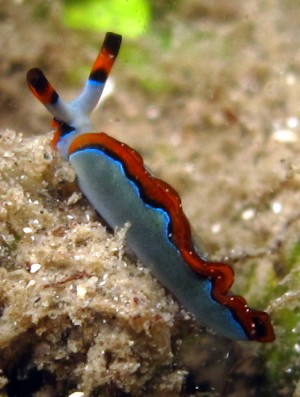
Thuridilla coerulea
(Kelaart, 1858)
Order: SACOGLOSSA
Family: Elysiidae
PHOTO
Locality: Near by Wandoor, 0.3 metres, Andaman & Nicobar, India, Andaman Sea, 8 March 2010, Intertidal, some Dead coral rocks beneath sediment. Length: 12-18 mm. Photographer: Vishal Bhave.
Thuridilla coerulea is blue with red-orange and black markings. The oral tentacles are orange red with a black edging and the upper half of the rhinophores are black with a central black band. The parapodia are blue with a broad red-orange margin and an inner thin black line.
As two similarly coloured species have subsequently been described [T. lineolata and T. undula] and as T. coerulea has not been reported since its original description it is appropriate to clarify its identity. Like many of Kelaart's description, it is brief but the accompanying illustration clearly show the colour pattern.
"This is a very small, beautiful species, about 3/4 inch long; when the wings are folded, it is not thicker than a crow's quill. Tentacles 2; blue with a central red ring, tip blackish. Body and wings blie; under part of head, and fore part of foot, red; edge of wing lines with black and red lines, the latter outermost."
Eliot (1906) reviewed Kelaart's specimens and drawings and noted that T. coerulea "can hardly be anything but Elysia lineolata of Bergh, which has a similarly gorgeous coloration, though there are some differences in detail. For instance, in Kelaart's animal the rhinophores have not red tips, but a red ring below a black tip." In Gosliner's (1995) review of Thuridilla, he tentatively kept the two species separate pending the rediscovery of animals fitting Kelaart's description.
If it were just the black tips to the rhinophores which separated T. coerulea and T. lineolata then I would agree with Eliot, but both Eliot and Gosliner have apparently missed the broad red-orange band running along the base of the parapodia in T. lineolata which is absent in Kelaart's original drawing and in Vishal Bhave's photo which accompanies this Fact Sheet.
Interestingly, Thuridilla coerulea is almost identical in colour to Gosliner's T. undula, differing in two details of the colour pattern. As its name suggests, the orange parapodial border in T. undula undulates with deep incursions into the blue part of the parapodia, while in T. coerulea the orange band is almost straight. The only other difference between these two species appears to be that the tips of the rhinophores are black in T. coerulea, while in T. undula this black tip is absent.
It is possible that T. undula, rather than T. lineolata, is a synonym of the earlier T. coerulea but we need to know more about the variability found in both 'species'.
- Eliot, C.N.E. (1906) On the nudibranchs of Southern India and Ceylon, with special reference to the drawings by Kelaart and the collections belonging to Alder & Hancock preserved in the Hancock Museum at Newcastle-on-Tyne. Proceedings of the Zoological Society of London, [for 1906] 2: 636-691. (Pls. 42-47). [Plate XLIII. Fig. 7 Elysia coerulea]
- Gosliner, T.M. (1995) The genus Thuridilla (Opisthobranchia: Elysiidae) from the tropical Indo-Pacific, with a revision of their phylogeny and systematics of the Elysiidae. Proceedings of the California Academy of Sciences, 49(1): 1-54.
- Kelaart, E.F. (1858). Description of new and little known species of Ceylon nudibranchiate molluscs and zoophytes. Journal of the Ceylon Branch of the Royal Asiatic Society, Colombo, 3(1): 84-139.with 2 plates
Rudman, W.B., 2010 (April 13) Thuridilla coerulea (Kelaart, 1858). [In] Sea Slug Forum. Australian Museum, Sydney. Available from http://www.seaslugforum.net/factsheet/thurcoer
Related messages
-
Re: Rediscovery of Kelaart's Thuridilla coerulea from Andaman and Nicobar Islands
From: Vishal Bhave, April 29, 2010 -
Rediscovery of Kelaart's Thuridilla coerulea from Andaman and Nicobar Islands
From: Vishal Bhave, April 14, 2010
